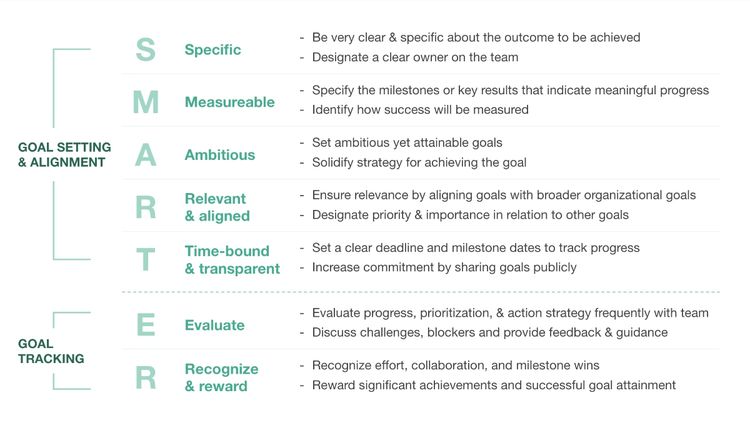
Setting and tracking team goals: let's get SMARTER

Written by

Former Director of People Science - Performance, Culture Amp
The effective use and alignment of team goals are one of the most powerful ways to enhance performance and drive success at the team level.
Decades of research show the positive impact goal setting has on performance. As a result of setting goals, the typical increase in employee productivity equates to $9,200 for people with an average salary of $50,000.
Of course, when goals are implemented and aligned correctly, the impact on productivity is amplified at the team level. Difficult goals produce significantly higher team performance, and team goals enhance collaboration by providing clarity on expectations, ownership, and purpose.
Further, a 2014 Stanford University study shows that having goals and a collaborative sense of purpose improves understanding of team success criteria and also enhances information flow and decision-making quality.
Turning science into action with SMARTER goals
So, as a manager or team member, how can you apply the most relevant science to ensure your teams’ goals are motivating, empowering, and effective?
Collaborate with your team and use these SMARTER guidelines:

Goal setting and alignment
Great managers empower their teams to succeed; collaboration is a core aspect of goal empowerment. Working together as a team to establish goals, milestones, and action strategy is one of the most essential components to creating meaningful, highly-motivating goals your team will rally behind.
When establishing and aligning goals, make sure the goals are:
Specific
Clarity is the foundation of effective goals and is critical in every aspect of the SMARTER model. It’s necessary to be specific about the long- and short-term objectives you expect to achieve. To do this, you can spell out the strategy for achieving each outcome.
Be specific about:
- Who owns the goal and is personally accountable for the team’s success? Who are the core contributors?
- Who will we share our goals with to get support and drive accountability? (Transparency)
- What exactly are we trying to accomplish?
- How will we gauge whether we succeeded? (Measurable)
- How will we recognize progress and celebrate wins? (Evaluated, Recognized, Rewarded)
- When does the goal need to be completed? (Time-bound)
- What are the milestone dates we need to hit along the way? (Measurable and Evaluated)
- What resources are needed, where can you find them, and what dependencies could derail progress or turn into blockers?
- Why is this goal important, and how will it impact the broader organization? (Relevant and Aligned)
Measurable
How exactly will your team know if they’ve succeeded in achieving the goal; what does success look like, and how can that be communicated to the organization? Of equal if not greater importance: how will you measure progress along the way and evaluate if your team is moving in the right direction at the right pace?
Designating specific milestones or key results is a powerful motivator and helps drive understanding around progress during evaluation and feedback sessions.
Ambitious
Goals that are difficult yet achievable produce the best results. Stretch goals can be a powerful motivator, but if a knowledge or skill gap may hinder success, identify what additional training or resources may be required to set the team up to win. Further, work with the team to specify how they will accomplish each of the steps along the way. Team discussions on goal strategy help drive knowledge transfer and clarity around expectations.
Relevant and Aligned
Be sure to review organizational goals with the team as a starting point to ensure everyone understands what’s important at the company level. When teams develop goals that align with organizational objectives, team members understand the importance of their work and feel a greater sense of purpose and motivation. When time and resources are constrained, aligning to broader objectives helps identify priorities.
Time-bound and Transparent
Setting a clear deadline for the overall goal and milestone dates to evaluate progress helps create a sense of urgency and drives focus on the key actions critical for success. Also, to maximize your team’s commitment to achieving the goal, make your team goals visible to leaders and colleagues.

Get started creating goal with your teams today
Goal tracking
Leaders must track goals once goals have been set (collaboratively!) and the team has started working toward them. Progress and outcomes need to be:
Evaluated regularly: How frequently the team evaluates progress depends on the goal and how the team operates, but in most cases, goals should be reviewed at least monthly. Feedback and guidance are an absolute necessity for team engagement and development. A few questions leaders can ask in team review sessions:
- How are we progressing?
- Are we on track to hit our next milestone?
- What percentage of the way to our overall goal are we?
- What contribution has each team member made?
- What wins have we had?
- What challenges or blockers are appearing?
- Are our actions and approach still appropriate, or is course correction needed?
Recognized and Rewarded: Finally, recognizing effort, persistence, and problem-solving is essential for maintaining the team’s motivation and optimism. It’s as invaluable to recognize small accomplishments as to reward big wins. Celebrating wins helps drive team confidence and motivation, which can lead to more significant commitment and motivation. This produces what is known as the “high-performance cycle.”
First steps toward setting SMARTER goals
It's important to remember that the SMARTER guidelines can be applied to essentially any goal framework, be it OKRs, tiered goals, backward goals, etc. For your teams to truly benefit from any goal setting, the core aspects of SMARTER need to be addressed. If any core piece is ignored, the impact on motivation and goal achievement will be seen over time, and there's a good chance teams will fail to achieve critical long-term outcomes.
Further, goals should never be a to-do list; instead, they should be motivational and clarify what you want to accomplish, how you'll get there, and what the timing looks like along the way to meet the deadline.
Lastly, they should detail how the outcome impacts the team and organization. The key results or "steps to get there" may include specific tasks or "to-do's," but even at that level, they should focus more on measurable outcomes that act as milestones. For example, you can adopt the principle of setting aligned employee development goals to drive both personal and organizational goals.
If you'd like to learn more about the goal-based psychological and motivational mechanisms that drive performance, check out our Science Behind Team Goals article.





